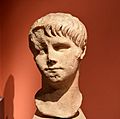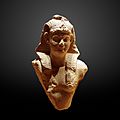Nero facts for kids
Quick facts for kids Nero |
|||||
|---|---|---|---|---|---|
| Emperor of the Roman Empire | |||||
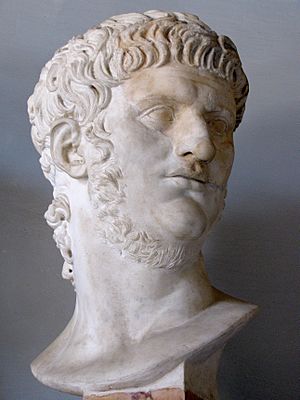
Bust of Nero
|
|||||
| Reign | 13 October, AD 54 – 9 June, AD 68 | ||||
| Predecessor | Claudius | ||||
| Successor | Servius Sulpicius Galba | ||||
| Born | 15 December 37 Antium |
||||
| Died | 9 June 68 (aged 30) Outside Rome |
||||
| Burial | Mausoleum of the Domitii Ahenobarbi, Pincian Hill, Rome | ||||
| Wives |
|
||||
| Issue | Claudia Augusta | ||||
|
|||||
| Dynasty | Julio-Claudian | ||||
| Father | Gnaeus Domitius Ahenobarbus | ||||
| Mother | Agrippina the Younger | ||||
Nero (born Lucius Domitius Ahenobarbus; 15 December 37 AD – 9 June 68 AD) was a famous Roman Emperor. He was the fifth and last ruler of the Julio-Claudian dynasty, a powerful family that ruled Rome for many years.
Contents
Nero's Early Life and Family
Nero was born on December 15, AD 37, in a town called Antium, which is now Anzio, Italy. He was the only child of Gnaeus Domitius Ahenobarbus, a politician, and Agrippina the Younger. His mother, Agrippina, was the sister of the third Roman emperor, Caligula.
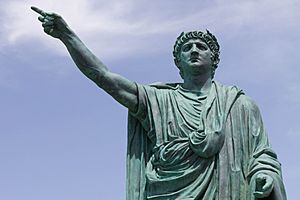
After Emperor Caligula died, Claudius became the new emperor. In AD 49, Nero's mother, Agrippina, married Claudius. She became his fourth wife. In AD 50, Claudius was convinced to adopt Nero as his own son. This is when Nero got his new name: "Nero Claudius Caesar Drusus Germanicus." To celebrate this adoption, Claudius even had special gold coins made.
Nero officially began his public life as an adult in AD 51 when he was 14 years old. When he turned 16, Nero married Claudius's daughter, Claudia Octavia. She was also his step-sister.
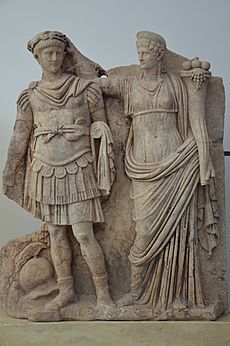
Emperor Claudius died in AD 54. Many historians from ancient times believed that Agrippina poisoned him. They thought she did this so that Nero could become emperor.
Nero's Time as Emperor (AD 54–68)
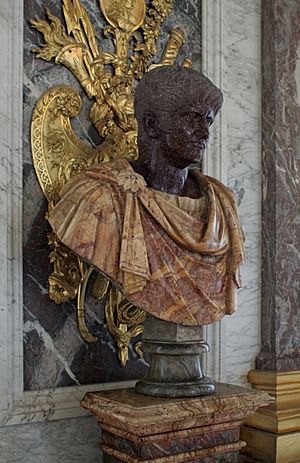
In the first few years of his rule, Nero received advice from his mother, Agrippina. He also had guidance from his teacher, Seneca the Younger, and his military commander, Sextus Afranius Burrus. However, Nero soon wanted to make his own decisions and rule independently.
Nero focused on improving Rome's diplomacy, trade, and culture. He ordered the building of new amphitheaters. He also encouraged athletic games and contests.
Nero enjoyed performing in public. He appeared as an actor, a poet, a musician, and even a charioteer. These performances made him very popular with the common people of Rome. However, some thought his public acts were not fitting for an emperor.
During Nero's reign, Roman generals achieved important things. General Corbulo fought in the Roman–Parthian War of 58–63 and made peace with the Parthian Empire. General Suetonius Paulinus stopped a large revolt in Britain. This revolt was led by Queen Boudica. Also, the First Jewish–Roman War began during his rule.
Most ancient Roman writers spoke very negatively about Nero. They often described him as a harsh ruler who cared only about himself. However, some modern historians wonder if these ancient stories are completely fair. They point out that Nero was quite popular among the common people of Rome.
The Great Fire of Rome
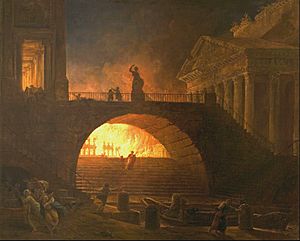
A huge fire started in Rome on the night of July 18, AD 64. Rome often had fires, but strong winds made this one much worse. The fire burned for over seven days. Then it started again and burned for three more days. It destroyed three of Rome's 14 districts and badly damaged seven others.
Some Romans believed the fire was an accident. Others claimed it was set on purpose, perhaps by Nero himself. However, some historians are unsure if Nero was responsible. He was in Antium when the fire began. He returned to Rome to help organize relief efforts. He even used his own money to help the victims.
After the fire, Nero opened his palaces to give shelter to people who lost their homes. He also arranged for food to be delivered to prevent people from starving.
To take suspicion away from himself, Nero blamed Christians for starting the fire. Many Christians were arrested and punished very harshly.
After the fire, Rome was rebuilt with better planning. New houses were spaced out and built with brick. They had porticos and were on wide roads. Nero also built a grand new palace called the Domus Aurea in an area cleared by the fire. Rebuilding Rome was very expensive. The government did not have enough money. To pay for it, Nero's government increased taxes. Heavy taxes were placed on the empire's provinces. Nero also made Roman money less valuable, which caused prices to rise for the first time in the empire's history.
Revolts Against Nero
In March AD 68, Gaius Julius Vindex, a governor in Gaul, rebelled against Nero's tax policies. Lucius Verginius Rufus, another governor, was ordered to stop Vindex's rebellion. Vindex asked Servius Sulpicius Galba, the governor of Spain, to join his rebellion and declare himself emperor against Nero.
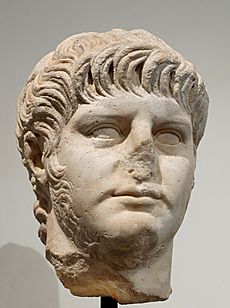
In May AD 68, at the Battle of Vesontio, Verginius's forces easily defeated Vindex's army. However, after winning, Verginius's own soldiers tried to make him emperor.
Even though Nero still had some control, support for Galba grew stronger.
Nero tried to leave Rome. He planned to go to the port of Ostia and then sail to one of the eastern provinces that were still loyal to him. But, according to the historian Suetonius, Nero gave up this idea when some army officers refused to obey him.
Nero returned to his palace in Rome. He woke up around midnight to find that his palace guards had left. He sent messages to his friends, but no one answered. When he went to their rooms, he found them all empty. He called for someone to kill him, but no one appeared. He cried, "Have I neither friend nor foe?" He then ran out as if he would throw himself into the Tiber.
Nero returned and looked for a place to hide. An imperial freedman (a former slave who had been set free), Phaon, offered his villa, about four miles outside the city. Nero and four loyal freedmen traveled there in disguise. Nero ordered them to dig a grave for him. At this time, Nero learned that the Roman Senate had declared him a public enemy.
Nero's Death
Nero lost his courage and asked his private secretary, Epaphroditus, to kill him. Nero's last words were "Too late! This is fidelity!" He died on June 9, AD 68. This was the same day his first wife, Claudia Octavia, had died. He was buried in the Mausoleum of the Domitii Ahenobarbi, in what is now the Villa Borghese area of Rome.
With Nero's death, the Julio-Claudian dynasty came to an end. A period of great confusion followed, known as the year of the Four Emperors.
Images for kids
-
An aureus coin showing Nero and his mother, around AD 54.
-
Emperor Nero being taught by Seneca, a sculpture by Eduardo Barrón.
-
An 18th-century woodcut of the historian Josephus (c. 37–100).
See also
 In Spanish: Nerón para niños
In Spanish: Nerón para niños



